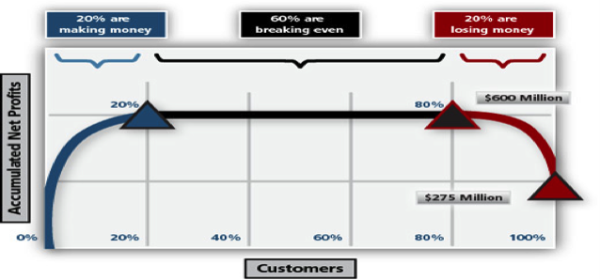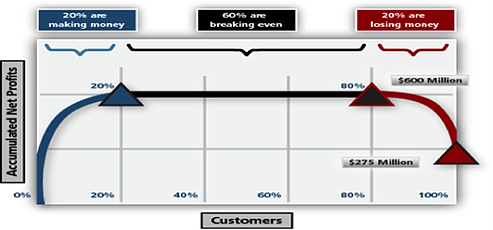CEO Blog - Advice for CEOs on growth and scaling
Customers Are Not All Equal

Why it’s important to understand customer value, and what to do about it
Every Management Team knows the intricacies of their respective P&L, but can they honestly say they understand the value that each customer delivers to their franchise? More importantly, if they have gone through the hard work of developing a robust customer profitability analysis, have they taken the next step to implementing key business changes based upon the data?(http://www.journalofaccountancy.com/Issues/2008/Dec/ManagingCustomerProfitability.htm)
I have worked for some of the leading Fortune 50 companies over my career, where the Leadership Teams actively managed their P&L’s to ensure top and bottom line growth. Not until I was “tapped on the shoulder” to take a senior leadership role in one of our “challenged” businesses, did we even start the discussion about how much each of our customers brought to the bottom line. It was important as we treated every customer the same – meaning, they received superior customer service. Theoretically, we would never consciously bring in unprofitable customers, but the reality was that every customer didn’t bring the same value to the bottom line.

So where does an organization begin?
1) Alignment: First and foremost, there needs to be alignment amongst the Leadership Team as to the proposed analysis in order to allocate resources by functional area to ensure knowledge transfer. Most importantly, agreement as to the implementation of a set of actions resulting from analysis must be gained. If there isn’t upfront alignment, a company risks spending a lot of time, opportunity costs (focusing on this initiative vs. others) and organizational strife along the way.
2) Cross-functional participation: No single individual or team can know all of the intricacies about how to allocate revenue and expenses, especially if a company doesn’t follow activity-based reporting & tracking. Each functional leader (or designee) should provide insight on how customer-driven activities are determined, e.g. customer, location or contract-level, etc., as well as associated costs (direct and indirect allocation, accounts receivable, credit rating etc.)
3) Principles-based decision-making: Establishment of principles for how decisions will be made is critical in order to fast-track difficult decisions so that model development can be gauged against these principles vs. pre-conceived notions as to which customers are ‘the best’. By identifying a core set of five principles, the team can make trade-offs on key strategic areas, e.g. fixed vs. variable costs, allocation of any revenue that is not directly allocated to individual customers, etc.
4) Determine ‘Must Keep’ vs. ‘Problem’ customers, along with other key themes: The model will highlight customers that the organization must keep independent of how cost-laden they are. Similarly, it may highlight new segments that require different acquisition and servicing strategies (too high a cost-to-serve within base plan), new channel opportunities, regions to increase investment, etc.
![]()
5) Develop and implement an organizational wide Action Plan: Data is great, but it needs to be translated into knowledge about the business, and most importantly a series of actions to capitalize the greatest benefits to the business, ranging from service/product differentiation, customer retention, pricing and customer acquisition:
- For your best customers, you need cross-functional participation on key initiatives such as renewal (including pricing), account management, servicing and product/service development. You may also want to establish Executive Sponsors for some of the key accounts with newly developed account action plans.
- For those that are challenged from a profitability basis, you need to determine what services may be changed, and as appropriate a revised pricing approach. Only if necessary, should you undertake a price-to-lose strategy – if a customer isn’t covering their costs to serve, you need to seriously question, the value they are bringing to your company.(http://hbswk.hbs.edu/item/4938.html)
Undertaking this type of approach requires commitment to “doing something” with the results, otherwise it was a theoretical exercise that will sit on someone’s desk. Automating the model and providing the key elements (revenue, margin, costs, credit rating, contract renewal date, etc.) on an on-going basis will provide valuable information to the sales leadership team to manage their respective books of business.
While it may take time to realize the final results, this type of approach will augment your business strategy and deliver positive impacts to your customers and shareholders alike.
Are you ready to take the plunge forward?
- Press Releases
- Careers
- Case Studies
- Marketing Consultant Company
- Marketing Strategy Consultants
- Marketing Plan Consultants
- B2B Marketing Consultants
- Virtual CMO
- Marketing Consultant Outsourcing
- Fractional CMO
- What is a Fractional CMO
- Healthcare Marketing Consultant
- Marketing Consultant Houston TX Texas
- Marketing Consultant Texas TX
- Marketing Consultant Bay Area
- CEO Blog
- Ebooks Plus
- Executive Marketing Consultants
- Product Marketing Consultants
- B2C Marketing Consultants
- Virtual Marketing Consultants
- Senior Marketing Consultants
- Temporary CMO
- Hire a CMO
- Fractional CMO Salary
- Fractional CMO Responsibilities
- Marketing Consultant Austin TX Texas
- Marketing Consultant Dallas TX Texas
- Marketing Consultant San Antonio
- Helping Private Equity
- Private Equity Blog
- Leadership Team
- Privacy Policy
- Business Marketing Consultants
- Strategic Marketing Consultants
- Marketing Technology Consultants
- Sales and Marketing Consultants
- CMO Job Description
- CMO Salary
- Fractional CMO Agency
- Fractional CMO Services
- CPG Marketing Consultant
- Marketing Consultant San Diego
- Partners
Houston, TX 77056
© 2023 Chief Outsiders


